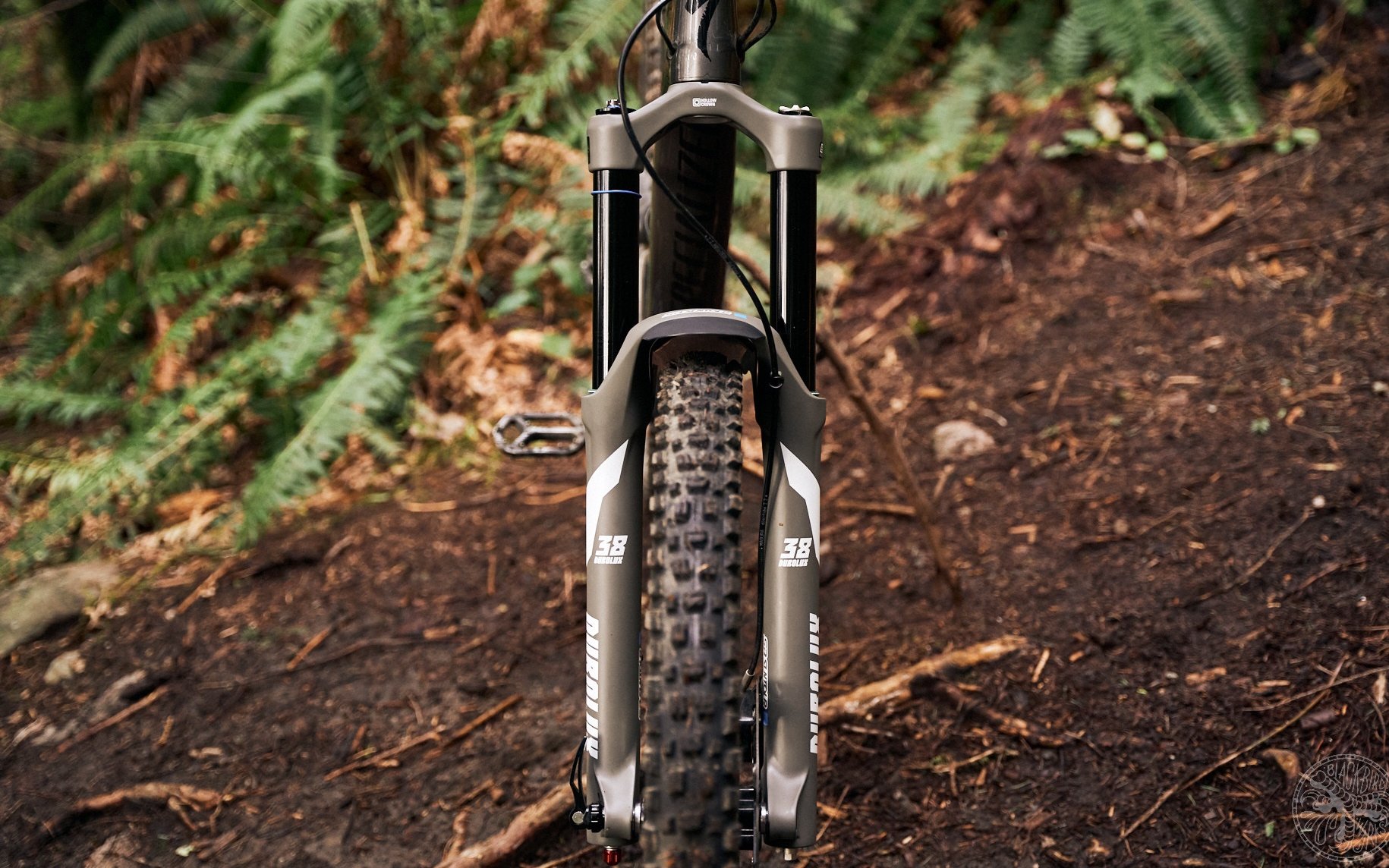
REVIEW
2022 SR Suntour Durolux 38 RC2
Bigger is better.
Fox? Or RockShox? As mountain bikers, we’re all expected to pick one, and be assholes about it. Of course, there are several other suspension options, and even among those, SR Suntour might not immediately come to mind. While they may be better known for their low-cost suspension products, that’s not to say that SR Suntour hasn’t thrown many hats into the high-performance ring over the years. New for 2022 is the Durolux 38 Boost EQ fork, SR Suntour’s entry into the 38mm chassis category. Brawler, freeride, enduro, super-enduro, or just plain “compensating for something” - whatever label you want to throw on them, 38mm stanchion, single-crown forks are popping up in many manufacturer’s catalogues. Bridging the gap between “trail-rated” single-crowns, and full blown, dual-crown DH forks, the 38mm chassis is meant for whatever heavy-duty application you can throw at it. Additionally, E-mountain bike ridership is growing rapidly, and with the added stress placed on the fork by these heavy machines, the 38mm format makes a whole lot of sense. With that in mind, it’s no wonder that companies are scrambling to get their fingers into the big fork pie.
The last time I wrote specifically about a fork, it was around the same time that Fox and Rockshox simultaneously released their first 38mm forks. Like many (most? all?) riders in the PNW, I experienced firsthand the shortcomings of the dainty, single-crown forks of earlier eras. Running a dual-crown fork on my trail bike did solve some of these issues, but I was still keen to see if the 38mm chassis could deliver on its promises of strength, stiffness and reliability. My experiences since then have shown that these bigger forks haven’t completely solved the single-crown woes, but they sure have pushed the needle in the right direction - a lot.
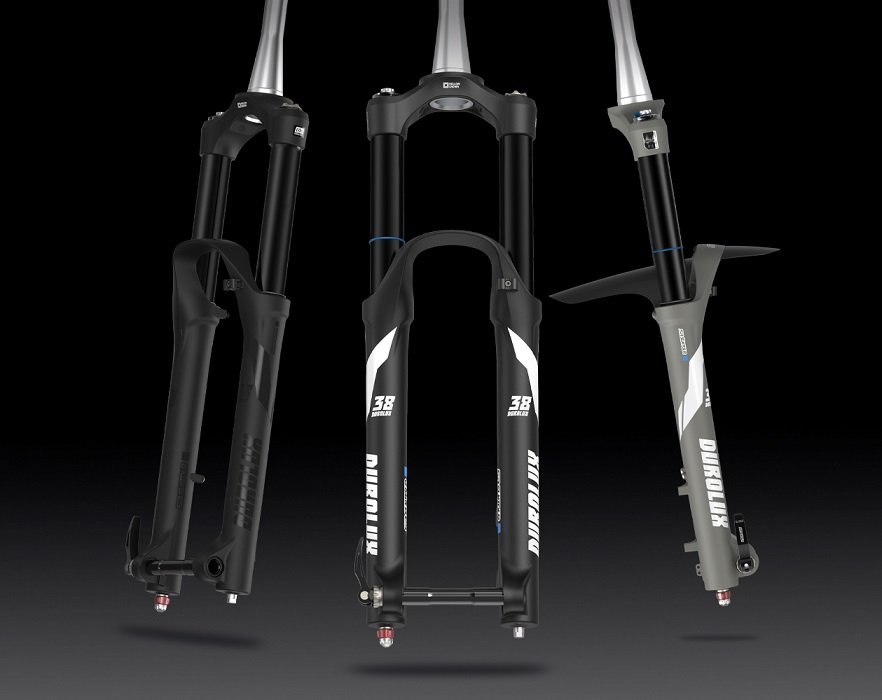
The Durolux 38 is available in three colours, two dampers, one offset, and any wheel diameter you like - as long as it's 29er.
When I heard that SR Suntour was coming out with a Durolux 38, I was eager to see how it stacked up against the Zeb and Fox 38 that I’ve spent so much time on in the last couple years. And while those forks are fantastic in their own right, there are still minor things that irritate me about both. I often catch myself wishing for a fork that combined the best attributes of the Zeb and the Fox 38 - it would be a damn near perfect fork in my opinion. It may be wishful thinking on my part to expect a fork costing several hundred dollars less to even swing in the same ballpark as the premium brands - but I’m happily willing to look past the scores of highly-paid, sponsored athletes, and slick marketing gimmicks to see how SR Suntour might do things a little differently.
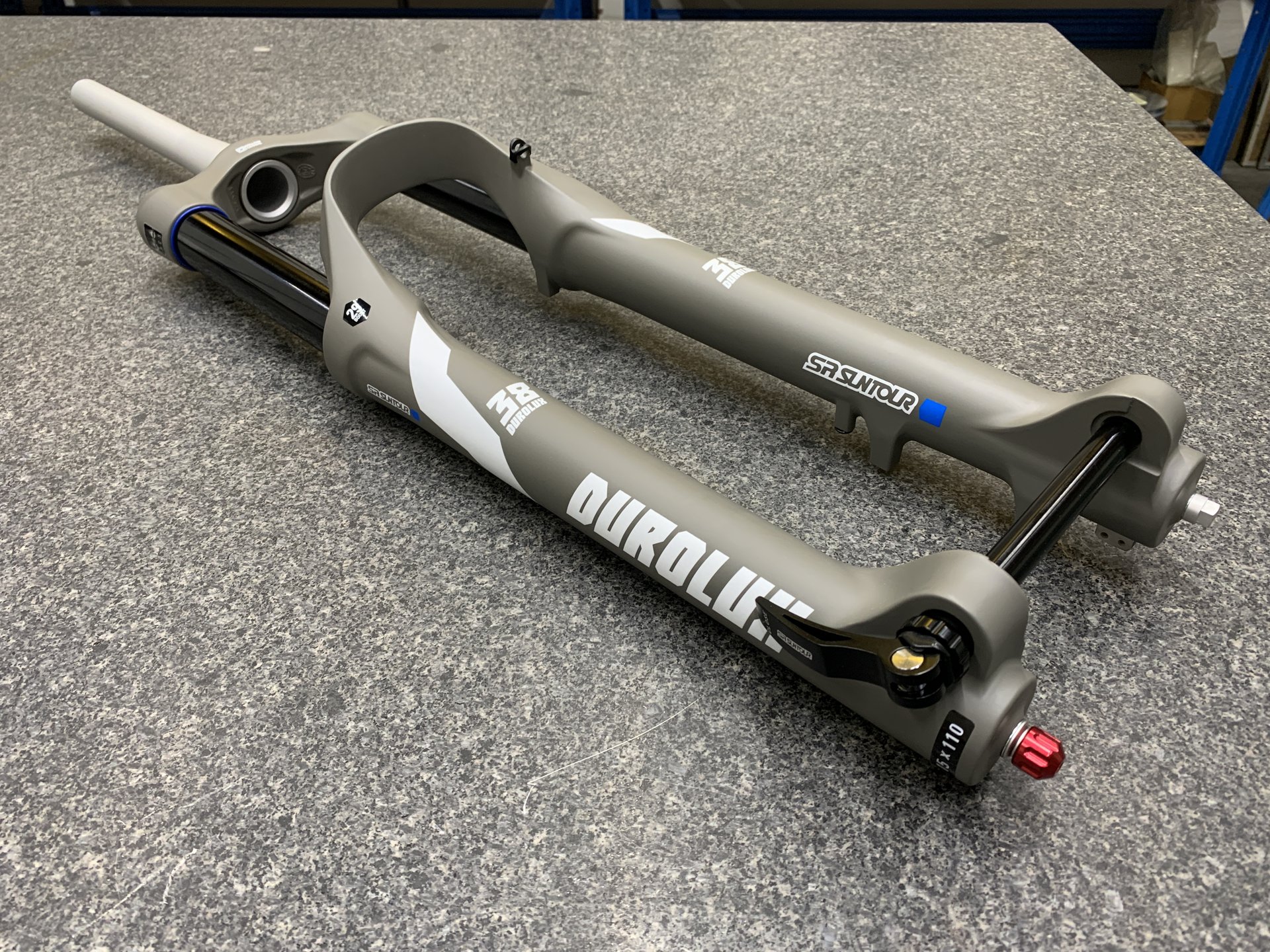
Military grade bicycle suspension.
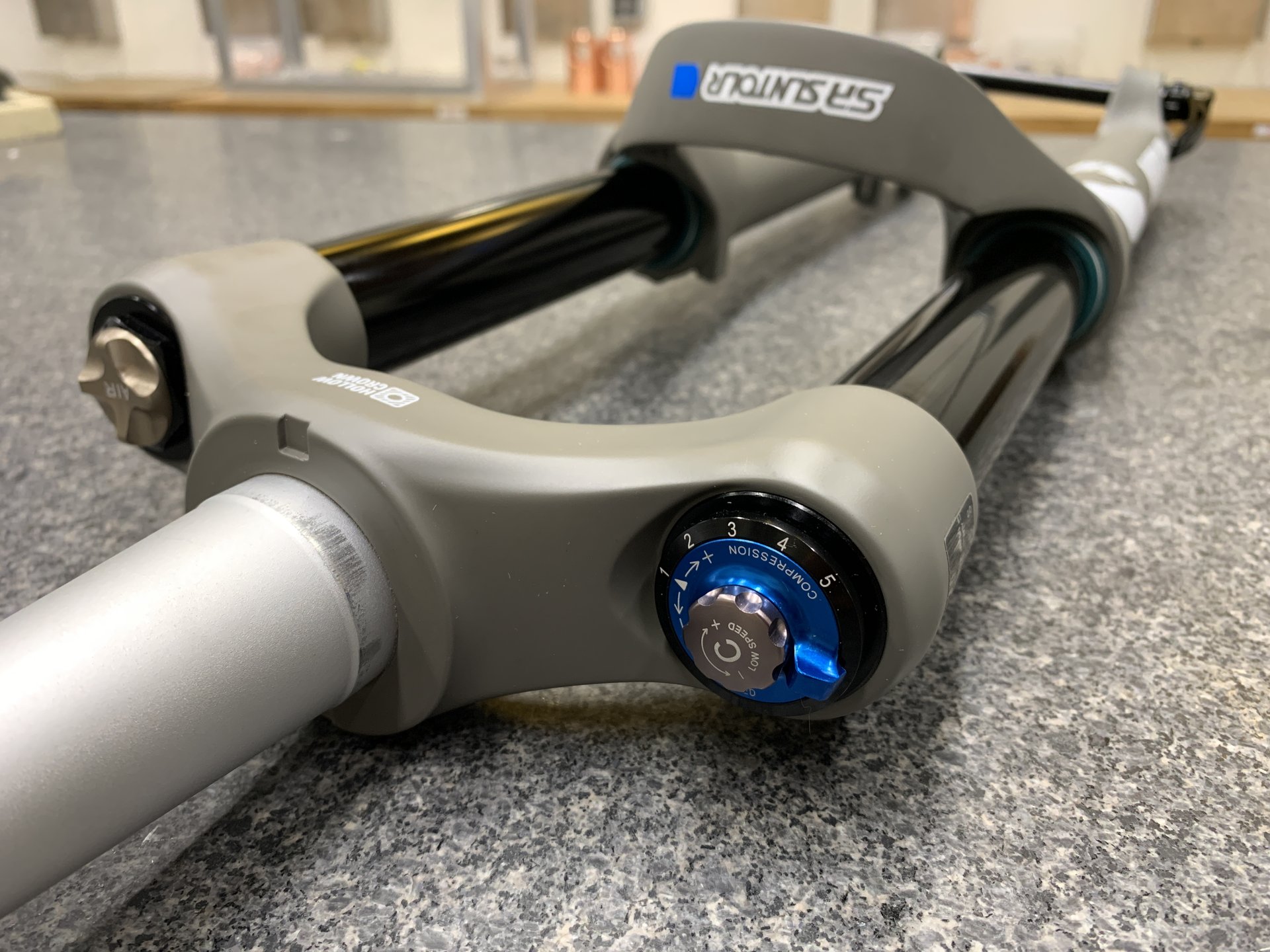
Damper adjustment knobs on the Durolux 38 are of very high quality and finish, and clicks are easily discernible. The single EQ air pressure valve is at the top of the left leg.
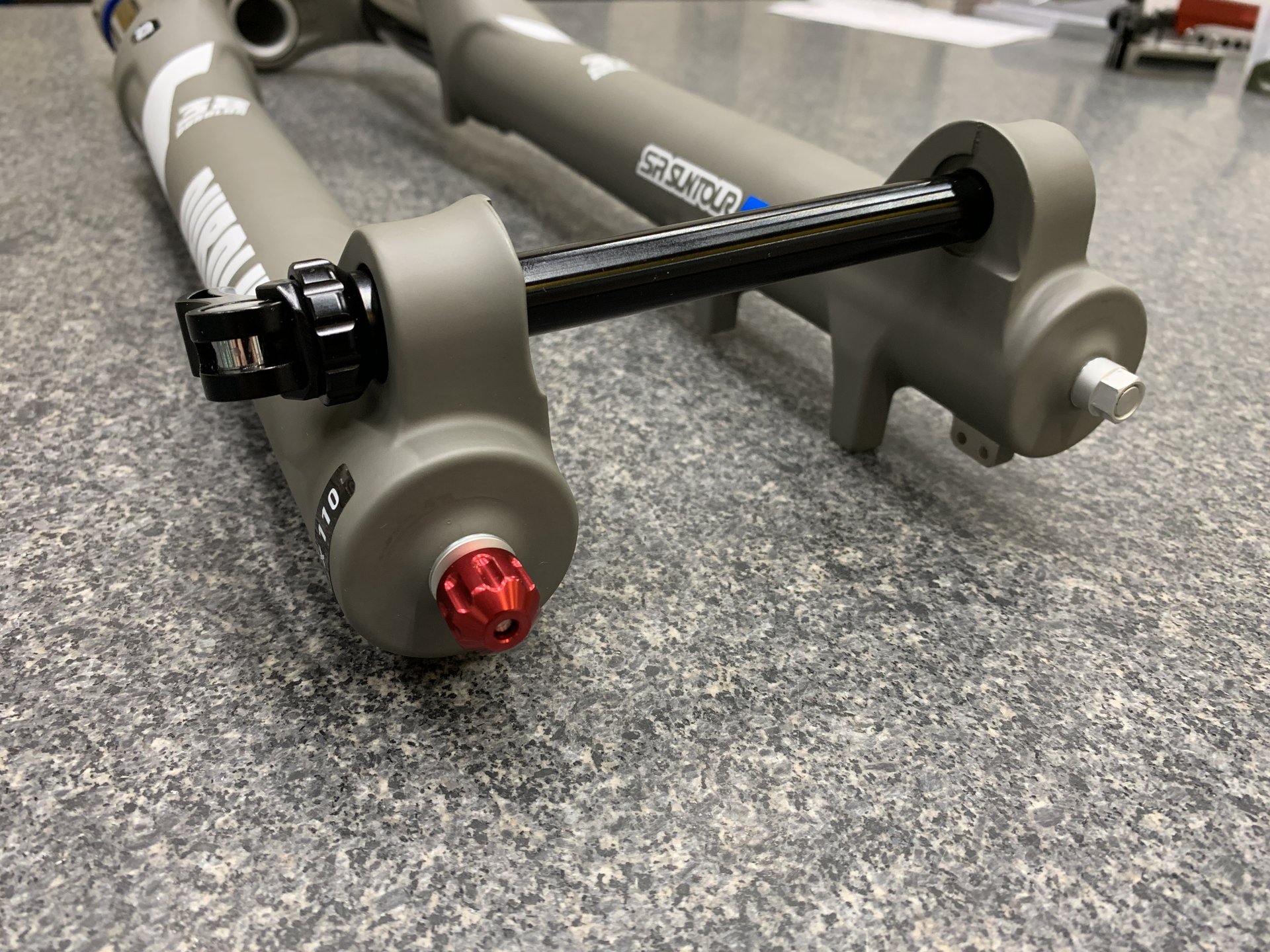
The lone rebound knob on the RC2 damper. The 15LH quick-release axle is standard equipment, but a simple Allen key thru-bolt is also available.
The details.
Currently only available for 29ers, the Durolux 38 sports a standard-ish offset of 44mm, and can be had in 160mm, 170mm and 180mm travel variants. The air spring is SR Suntour’s “EQ Equalizer System”, which is just their way of saying that the positive and negative air chambers are equalized automatically by way of a transfer port. Earlier models of the Durolux relied on a coil negative spring that came in different weights to tune the top-of-travel characteristics. As it eliminates the coil spring, the EQ System is lighter, and easier to set up in practice. And while it’s arguably a step in the right direction, transfer-port-equalization has been done by Fox and Rockshox for ages, so it’s not a new idea by any means.
On the damper side, you have the choice of SR Suntour’s RC2-PCS, or the R2C2-PCS. As you may have guessed, the RC2 includes one external adjuster for rebound, and two for compression (high speed, and low speed). The R2C2 splits external rebound adjustment into separate high and low speed knobs. If you like how Fox does things, or if you’re just predisposed to endlessly faffing with your bike, you might prefer the extra knob to twiddle on the R2C2. For the review, SR Suntour sent me a 180mm travel Durolux 38 with an RC2 damper. MSRP for the Durolux 38 RC2 is downright affordable, at $1079.99 CAD / $800.00 U.S.*
*(Aaaaaand, cue the peanut gallery, lamenting the fact that a thousand dollar bicycle fork is considered "affordable".)
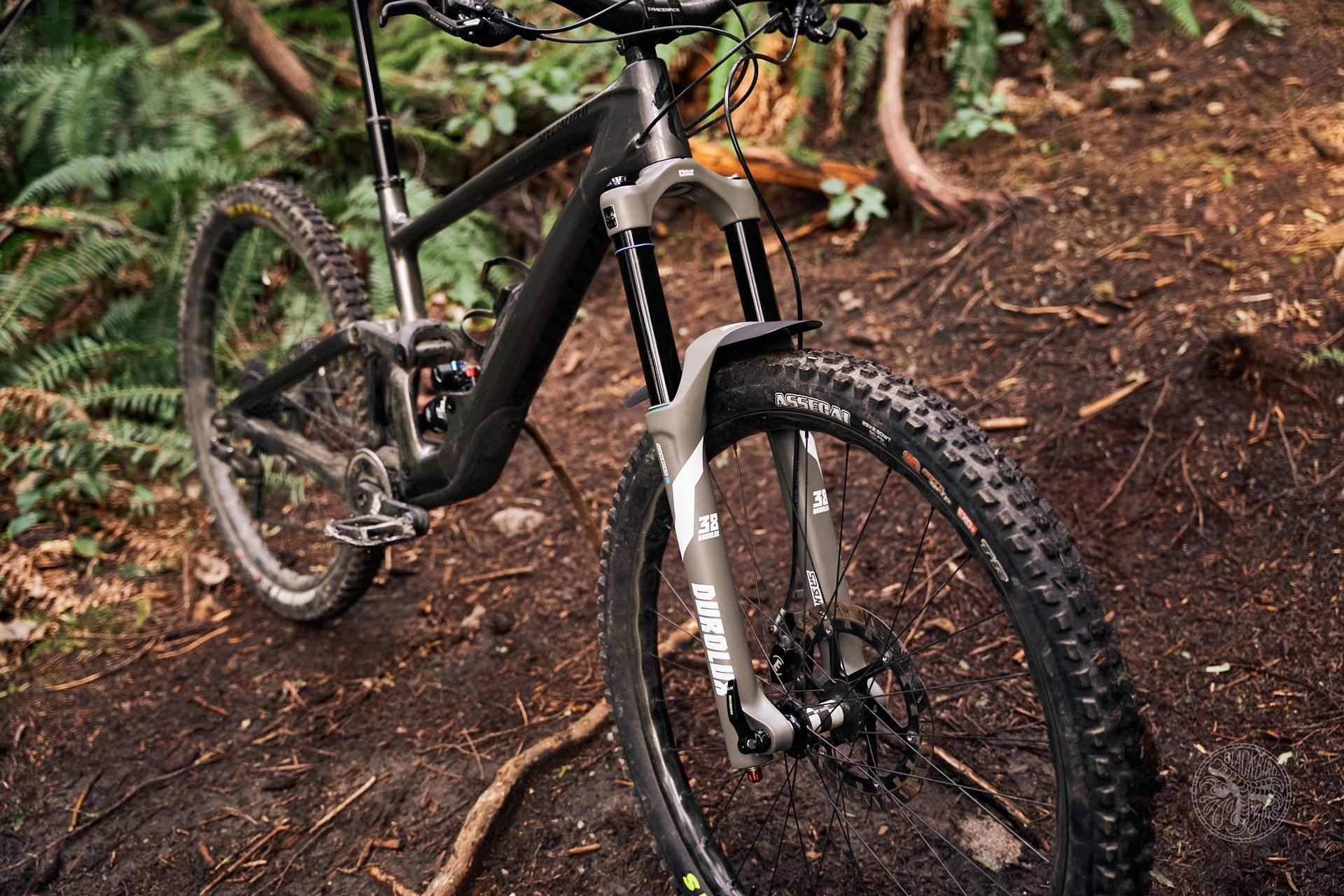
The Durolux 38 is a serious looking piece of hardware. Not as serious as my cable lengths though.
Straight out of the box, the Durolux 38 strikes a formidable presence. This is a beastly fork, whose solid heft and battleship grey paint give the impression that you might just be holding a piece of military hardware, rather than bicycle suspension. With an actual, measured weight of 2648g, the Durolux is definitely on the porkier side of the spectrum - 340g heavier than my Zeb. I’m not a weight-weenie by any means, but strapping an extra ¾ lb to the front of my bike is enough to give even me pause. My 36lb “trail bike” should make it plainly obvious that given the choice between performance and lower weight, I’ll always choose performance, so we’ll see if the extra grams pay off for the Durolux. The fork comes with SR Suntour’s 15LH quick-release axle as standard, and allows for tool-free removal of the wheel. The quick-release is easy enough to adjust and operate, although I personally prefer the simplicity and cleaner look of the optional Allen key thru-bolt. Also in the box is a very slick, removable fender that forgoes the junky zip-tie attachment in favour of three sturdy bolts. Finally! A fork that comes equipped with a proper fender as standard equipment! Fox and Rockshox - are you taking notes?
At the top of each lower tube, you’ll find a small set screw on the backside. These ports can be used as air bleeders, similar to what you’ll find on other forks, but seeing as you have to fully unthread them with an Allen key (and make sure not to lose them in the process), their usefulness as bleeders while out on the trail is limited. Perhaps SR Suntour will release a push-button bleeder in the near future to replace the set screws - but I’m far more interested in the second reason that these ports exist, and that is the ability to inject lower leg lubricant directly into the fork, without dropping the lowers. The Durolux 38 ships without any lower leg oil at all - the bushings are greased, but otherwise, the lowers are dry. SR Suntour understands that their suspension-savvy customers often add oil to their fork lowers in search of the slipperiest action possible, so they made the process super easy with the addition of the bleeder / injector ports. It’s possible to add up to 10mL of oil to each leg, although SR Suntour recommends just 1 or 2mL at a time. Think of it as a mini lower leg service, for lazy people like me. After you’ve added a cumulative total of 10mL to each leg, you will need to drop the lowers and drain the old oil before adding any more. I’m a sucker for a supple fork, so I added 5mL of 20wt suspension oil to each leg before hitting the trails.
I’m not going to dwell too long on the looks of the Durolux, as I’m definitely more interested in how it performs on the trail. That said, while I wasn’t so much a fan at first, the military grade appearance is growing on me. The matte grey paint seems very durable, and the patina that is developing as ride time accumulates is kinda cool too - adding character to its already rough and ready demeanor. It’s a shame the graphics are about 20 years too late, because SR Suntour went to the trouble of screening them on permanently, rather than going with flimsy stick-on decals that seem to be the industry standard. The irony of finally having graphics that won’t peel off, even though I kinda want to peel them off, is not lost on me. And if the battleship grey doesn’t float your boat, the Durolux 38 is also available in matte black. As mentioned earlier, the included fender is beautiful and functional, fitting perfectly into the shape of the fork arch.
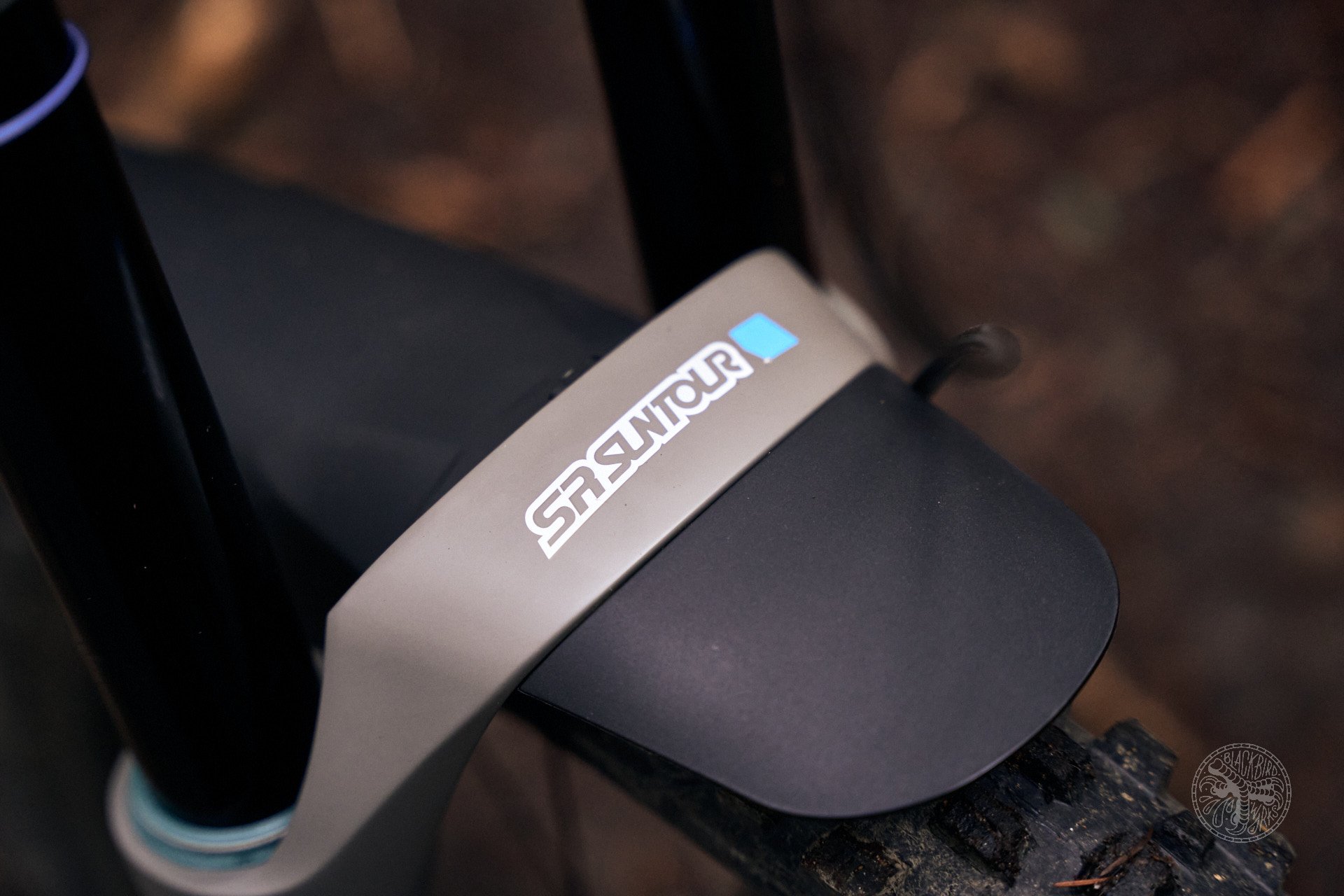
Form and function - have both! Seriously, why can't we have fenders this nice included with forks that cost significantly more money?
The setup.
Being a new platform, initial setting recommendations are hard to come by for the Durolux 38. When setting up a fork, I prefer the spring to do most of the work on the compression stroke, while relying on the damper as little as possible. This might explain why I have an impressive collection of volume spacers in my parts bin. The Durolux 38 uses two types of volume spacers - a hard resin style (3 maximum), and a soft rubber style (6 maximum). Previous experience has taught me that I’ll get to my preferred settings quicker by starting off with plenty of spacers in the fork, rather than none. This might seem like putting the cart before the horse - but I’m a chonky boi, with an aversion to bottomed-out forks, so I opted for one less than the maximum number of spacers (3 resin, 5 rubber). Throughout the test, I experimented with varying numbers of spacers, but ultimately settled back at my initial count of 3 and 5. Not too bad for a stab in the dark, eh?
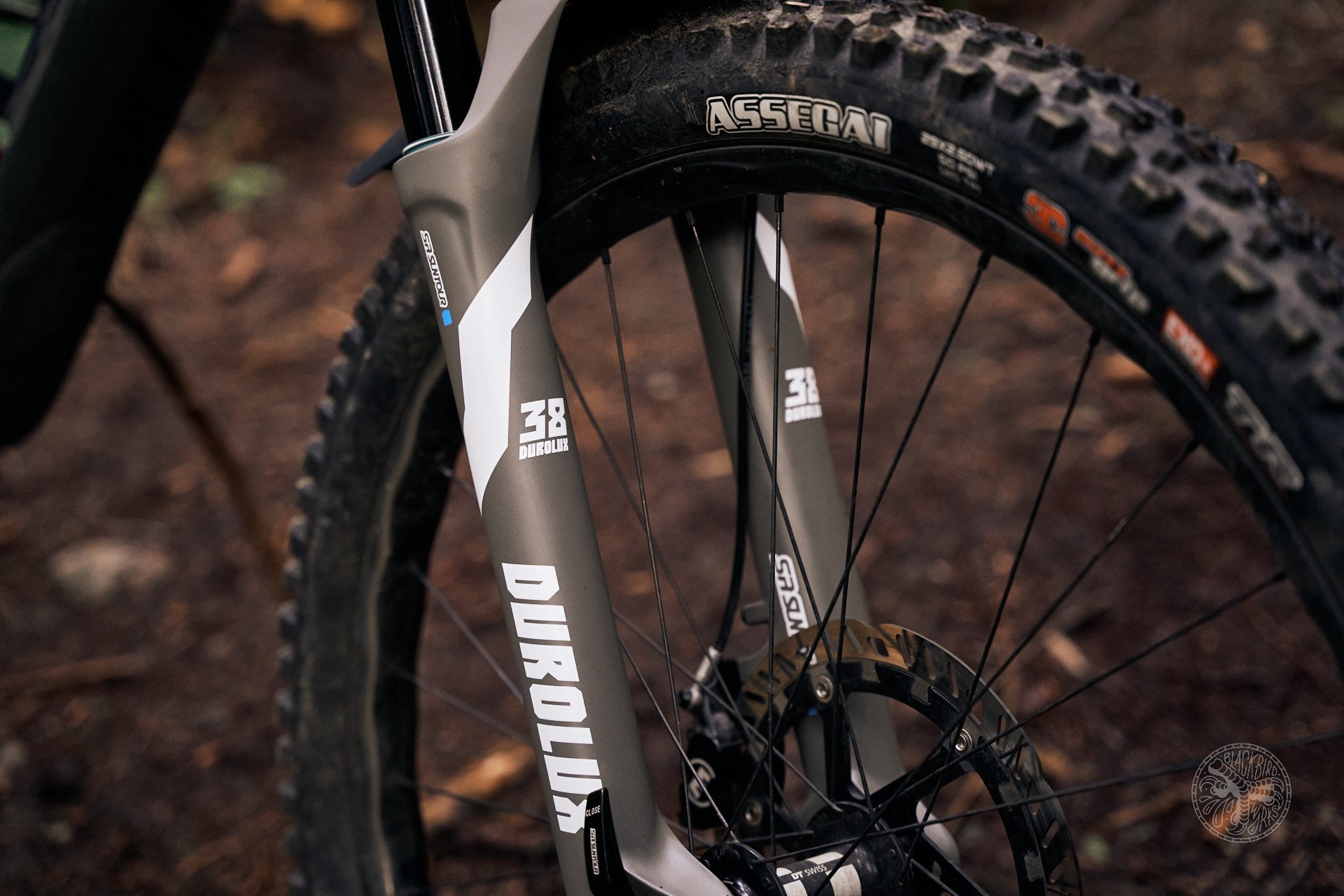
Better graphics don't cost much compared to retooling.
With that baseline of tokens established, I started with an air pressure of 62psi, which got me in the neighbourhood of 20% static sag. Without any recommendations to go from, I initially set both compression knobs pretty close to centered. HSC has a range of 5 clicks, while LSC gives you 16 clicks. The one and only rebound knob gives you 21 clicks, and I was quite astonished at how heavily damped the rebound stroke felt on this fork - I settled on 18 clicks out from fully closed on the rebound adjuster.
Within the first few minutes of riding, it became clear to me that the compression damping on the Durolux 38 is similarly strong as the rebound circuit. The heavily damped nature of this fork shouldn’t really come as a surprise, with a healthy representation of big mountain freeriders on their roster, SR Suntour has built this fork to handle hits that mere mortals would never dream of attempting. For the trail conditions at my paygrade, I found I had to run the HSC all the way open to achieve the sensitivity and traction I was looking for. Clydesdales are going to love this fork, whereas lighter riders are going to struggle moving enough oil through the stock damper. Thankfully, both available dampers are fully serviceable, so getting the right tune for your weight and riding style can likely be done at any SR Suntour service centre.
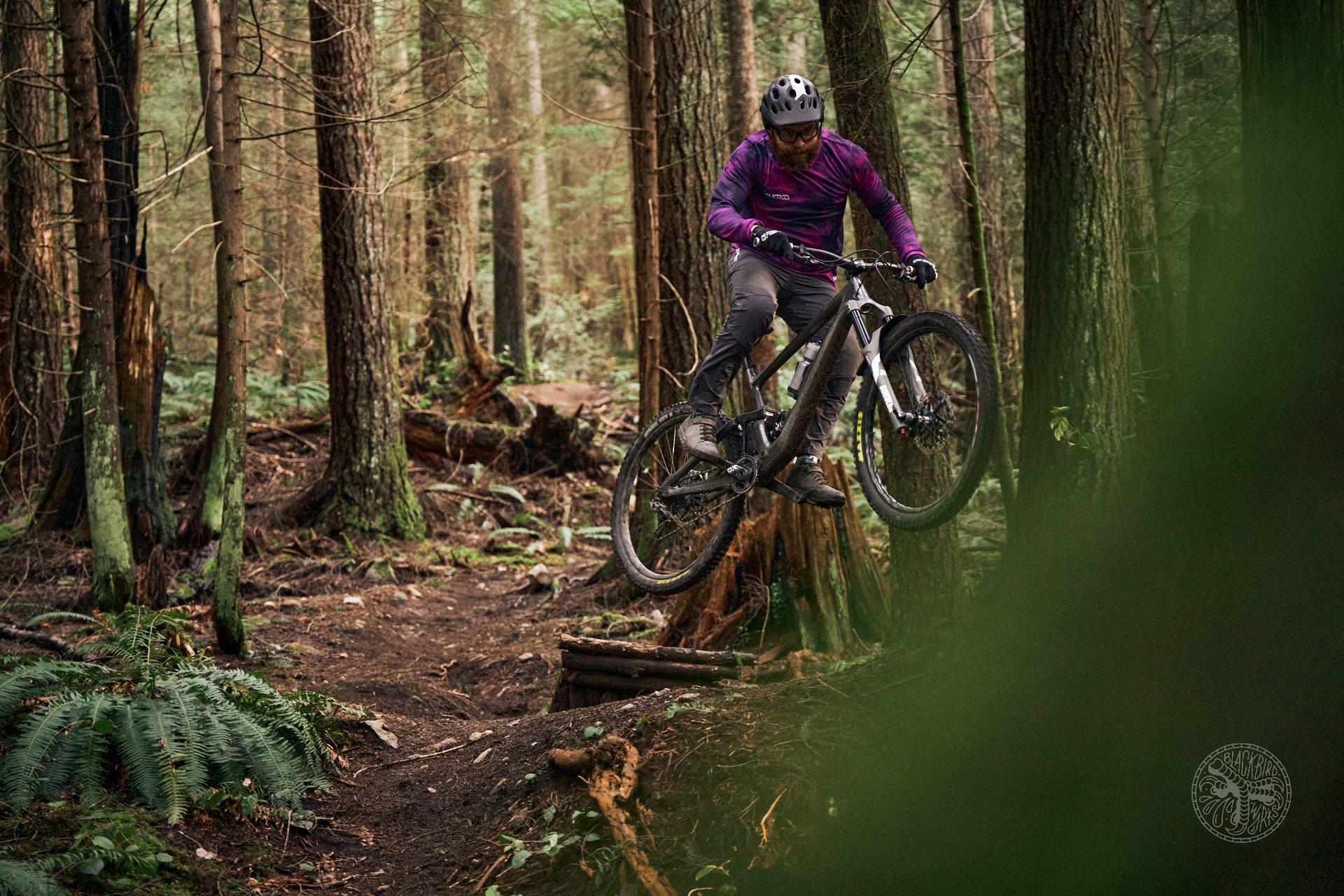
The Durolux 38 eats up terrible landings.
The ride.
Over the first few rides, my initial impressions of this fork were somewhat mixed. While I couldn’t quite put my finger on it, the Durolux felt a bit sticky. If I hadn’t injected the lower leg oil myself, I’d almost suspect the culprit to be dry and/or tight bushings. This sticky feeling was detrimental to small bump sensitivity, and was most apparent when negotiating off-camber roots or wet, slippery surfaces where keeping traction was of paramount importance. The Durolux just didn’t have the supple, slippery feeling of other forks in this segment. In an effort to improve things, I decided to drop the lowers and do a thorough re-greasing and lower leg oil treatment of the fork. After this, and a few more rides, the sensitivity improved quite a bit, but never caught up to the competition. I have to wonder about the fact that I was running the HSC all the way open, with no more clicks to go. Perhaps the sensitivity could have improved further if I was able to open that damper up a little more? The initial stickiness of the fork could also be attributed to tight bushing tolerances, and this would also explain why it seemed to improve over time. Whether it was caused by low lube, tight bushings, the strongman damper, or some combination of the three, the small bump sensitivity continued to improve throughout the review period.
Through some further bracketing, I ended up with slightly higher air pressure, and higher LSC as well. SR Suntour should be applauded for including adjustments on this fork that actually make a discernible difference in ride characteristics. Dialing in a few clicks of LSC resulted in a fork that rode noticeably higher in its travel, without adding any harshness to the compression stroke.
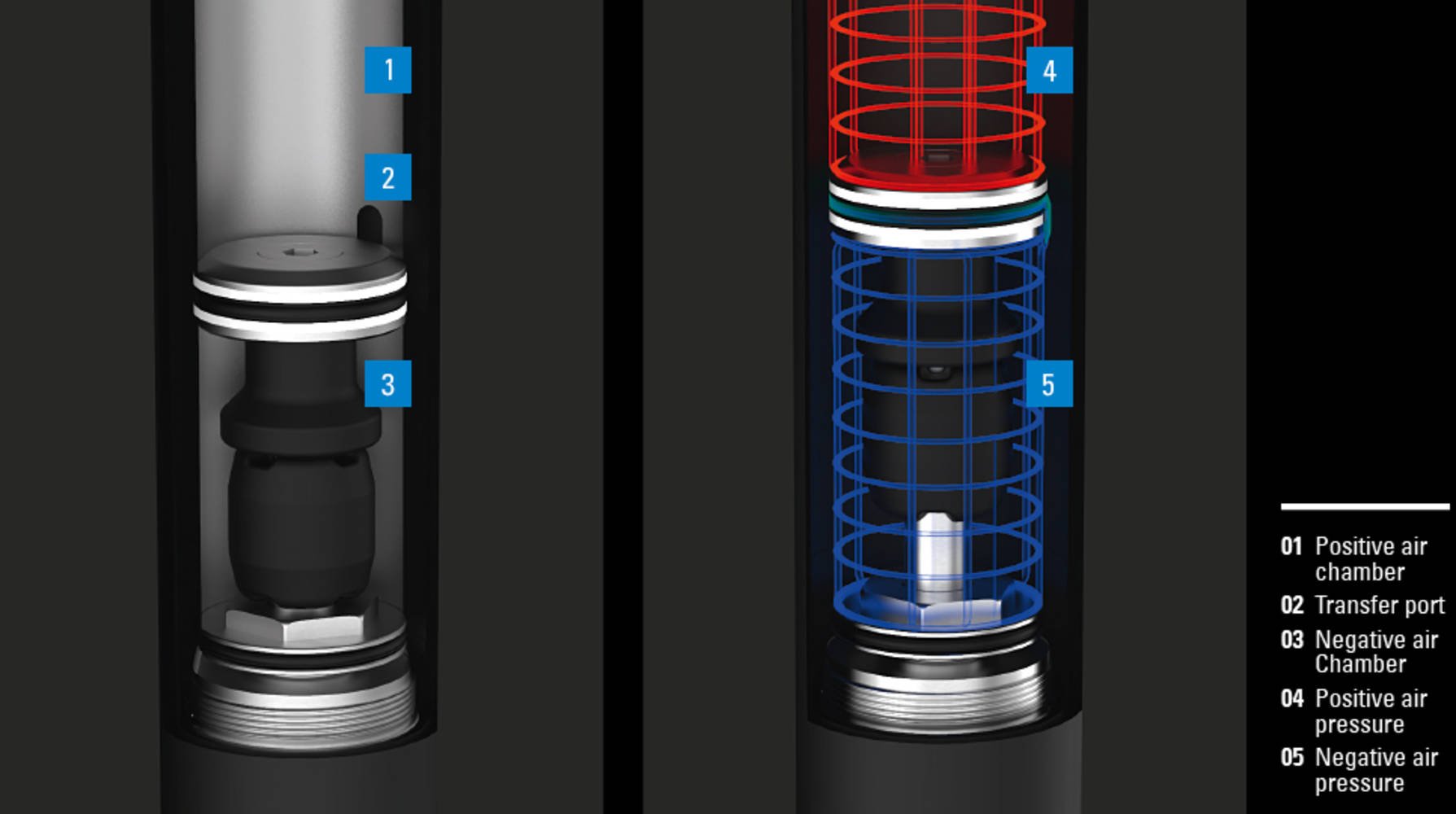
The business.
These are the settings that I ultimately stuck to for the majority of the review. I’m about 190lbs fully geared up.
- EQ Air Spring Pressure: 65psi.
- Volume Spacers: 3 resin, 5 rubber.
- HSC: Position 1 (lowest setting out of 5).
- LSC: 5 clicks out from fully closed (16 clicks total)
- Rebound: 18 clicks out from fully closed (21 clicks total)
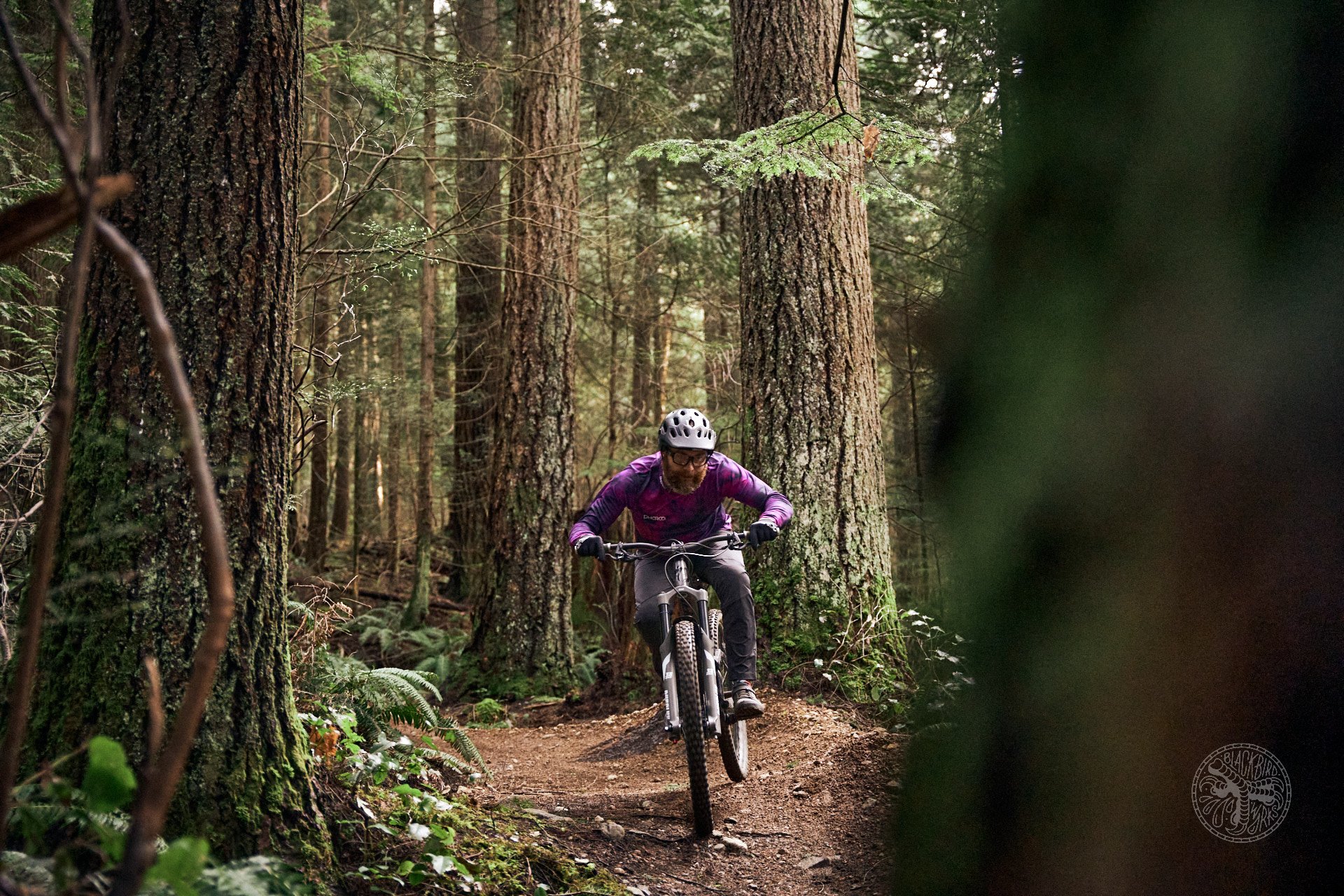
An example of terrain that's far too mellow to wake up the Durolux 38.
With the Durolux dialed in, it was time to set it loose on some rowdy terrain. While off-the-top sensitivity is not this fork’s strong suit, plowing through all manner of chunder with reckless abandon certainly is. The freeride DNA in this fork is unmistakable - the Durolux 38 feels most comfortable when you’re feeling your least comfortable. The stout chassis holds an impressive line when things get really wild, and with all those tokens, the EQ spring does a great job of resisting bottom-outs on even the biggest hits. While the rebound damping range is too slow for most applications, it can be set quick enough to recover from fast hits at race pace, although it’s not quite as refined on the rebound stroke as the Zeb or Fox 38. I found I had to run a touch more rebound damping than I would have liked, to eliminate the barely perceptible top-out rattle experienced at fast rebound speeds. Still, the Durolux is downright incredible on the fastest, roughest trails - even better if they have massive airs to blown-out landings. The heavily damped RC2 is eager to press hard off lips, and is just as happy when it comes time to deploy the landing gear - it’s as if SR Suntour set out to make a freeride fork for dirt jumpers. There certainly are forks better at staying glued to the ground, but if jumping into and out of trouble is your idea of a good time, then the Durolux is hard to beat.
When things get steeper and slower, the Durolux has no problem keeping things under control, with the caveat being that slippery and/or off-camber surfaces require a bit more of the rider’s attention than with the velvety smooth competition. But when conditions are dryer, and hits are coming fast and furious from straight ahead, the Durolux remains unfazed while gobbling up everything in its way. While I might be more inclined to side-step certain trail obstacles with other forks, the Durolux prefers to go straight down the fall-line, regardless of what’s in the way. I’m still processing how this could be possible in a fork at this price point but I think SR Suntour just might barely edge out both RockShox and Fox when it comes to straight-line plowability - no easy feat, considering the more expensive competition are no slouches in this regard.
The freeride DNA in this fork is unmistakable - the Durolux 38 feels most comfortable when you’re feeling your least comfortable.
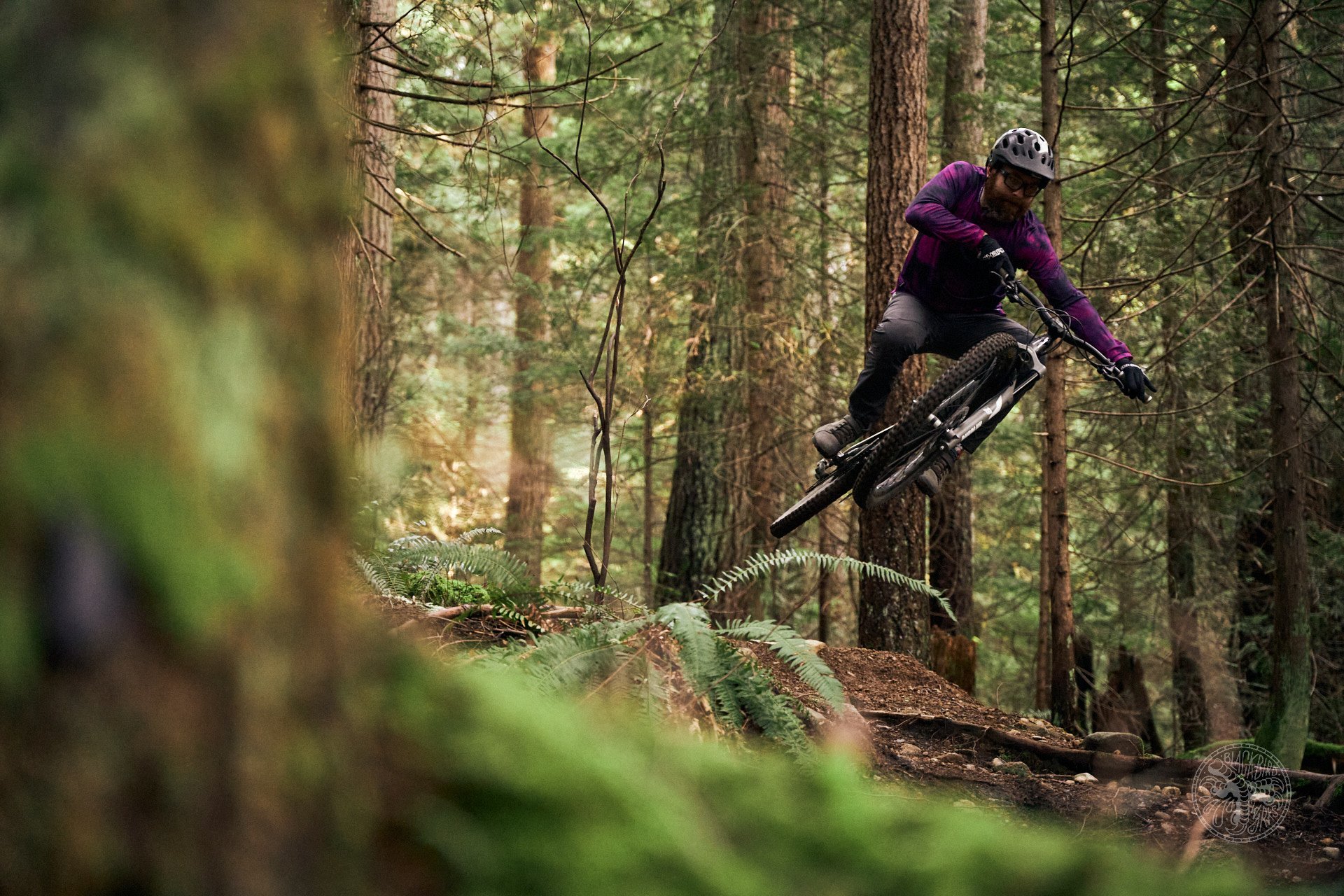
With its stout chassis and heavy-duty damper, the Durolux 38 is a jumper's dream.
38mm for the masses.
All things considered, it seems that SR Suntour has cooked up a working class winner in the Durolux 38. To be truly competitive in the enduro race scene, where traction is king, and milliseconds matter, SR Suntour will have to improve the sensitivity of the fork, and it might not hurt to put it on a wee diet as well. But for riders who are just looking to ride some gnarly shit, without having to remortgage their home, it’s hard to argue that the Durolux 38 isn’t a great option.
I walked into this review not expecting too much from this affordable fork, but I can’t stress enough how impressed I am with its overall performance. When it comes to bang-for-your-buck, SR Suntour has handily beaten the competition with the Durolux 38.
$1079.99 CAD.
$800.00 U.S.
Age : 40
Height : 1803mm
Weight : 86kg
Ape Index : 1.03
Inseam : 787mm
Bar Width : 780mm
Preferred Reach : Pretty comfy at 487mm these days.
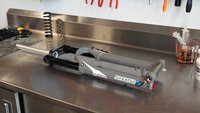

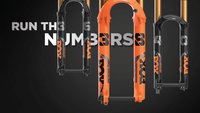
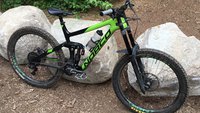







Comments
Ripbro
1 year, 10 months ago
Suntour would sell more forks if they looked better. It’s sad but I think it’s true.
They should pick an anodized color for their compression adjuster (purple, pink, something that stands that hasn’t been used).
Update the logo/rebrand for their premium products, kind of like trp.
Battleship grey is an ok colour.
Mountain bikers can be a vain bunch, products that look good sell, even when the performance isn’t there.
Reply
kcy4130
1 year, 10 months ago
I know it was a typo, but I love the phrase "mountain hikers". I'm going to say "I'm going mountain hiking" next time instead of saying "I'm going for a walk in the hills". It just sounds cooler. And I agree, the styling shouldn't be important, but it always is at least a little important. I don't like the grey, it looks intentionally drab and utilitarian, like the color they'd paint a prison or something.
Reply
Mammal
1 year, 10 months ago
Totally agree about the graphics, which is why the blacked-out model they now offer is a big improvement. At least they got rid of the awful graphic that was on the arch for ages. Andrew Major usually tests the Suntour products on NSMB reviews, and ALWAYS mentions that.
Reply
StacheTower16
1 year, 10 months ago
I have a Durolux, partially based on Andrew's review, and I ended up buying custom decals. Love the fork, but those graphics are no bueno.
Reply
Cooper Quinn
1 year, 10 months ago
I mean, the Zeb seems to do ok, and it doesn't have any color anodizing, and is grey?
Reply
AndrewR
1 year, 10 months ago
Or black but it is easy to get a custom decal kit from StikRD or SlickGraphics for the Zeb if one wants to individualise the fork.
Reply
skywalkdontrun
1 year, 10 months ago
I think some of your issues might be alleviated by removing some volume spacers. It seems to me that volume reduction has been marketed for entirely the wrong reasons. As a heavier rider you (and I) need more volume in our air springs, not less, in order to achieve proper compression curve. My recommendation would be to try removing most (if not all) of the volume spacers and seeing what can be done about adjusting compression with air pressure. You may find the fork moves through its travel more smoothly.
Reply
Ryan Walters
1 year, 10 months ago
My experience with various air forks has taught me that proper setup is a lot more complicated than it may seem. Every fork is a bit different, and there are many things to consider (things that are difficult to get hard data on), like the static volume of the positive and negative air chambers. At the settings I settled on, I was still able to bottom the Durolux on occasion, and the stickiness was only an issue at very top of travel. Once the fork was moving, it was less noticeable. If I removed tokens (all of them!?), I would have to substantially increase the air pressure, making the top of travel even stiffer. I like a good ramp up in my fork, and through plenty of experimentation, I’ve never run a fork without a fair amount of tokens. Case in point: I run my Zeb with the max number of tokens, and it feels dreamy. The difference in suppleness between Zeb and Durolux is huge. I think the Durolux issue boils down to the damper and possibly tight bushings.
Riding style also has a lot to do with setup - I tend to ride quite forward on the bike, so I need extra support in the fork.
That said, you've given me an idea - out of sheer curiosity, I'll take all the spacers out of my Zeb and reset the air pressure to achieve the same sag. I'll go for a ride or two, and try to report back here.....
Reply
Karl Fitzpatrick
1 year, 10 months ago
I'm not as much of unit as you profess to be but I've always found that no tokens, less pressure and more compression (like all of it) is what works for me...
But yeah, we're all different haha
Reply
Ryan Walters
1 year, 10 months ago
Man, you’ll love the Durolux. All the damping!!
Reply
Karl Fitzpatrick
1 year, 10 months ago
If only I could stock of the fabled Suntour Zeron Coil Fork. #sadface
Reply
fartymarty
1 year, 10 months ago
Out of interest does anyone store their bikes upside down (BMX style) so the oil runs down into the foam rings under the seals?
Reply
MTBrent
1 year, 10 months ago
I was just thinking of this last night while parking my bike.
I remember Darren from Push (I think on Vital's podcast?) saying that after climbs/before descents he would hold his bike with the front wheel in the air and the fork inverted to get the lowers lubed up top to bottom and that there was a noticeable difference when doing so. I've never tried it, but I'd say he knows a thing or two about suspension so there must be something to it.
Reply
Justin White
1 year, 10 months ago
Considering Fox added channels to help this happen, it's definitely a thing. I do the same, but not every climb, just before a ride if my bike slept on the work stand instead of hanging by the front wheel.
Reply
Ryan Walters
1 year, 10 months ago
Out of necessity (for storage reasons), I store my bikes hanging vertically from the rear wheel. Although this wouldn't have quite the same effect as storing upside down, I do think about this as well.
Reply
Vik Banerjee
1 year, 10 months ago
I store my bikes hanging from the front wheel so the oil pools at the seals. Not for that specific reason, but it’s a side benefit.
Reply
Mammal
1 year, 10 months ago
If my bike hasn't been stored upside-down prior to a ride, I try and make sure I turn it upside-down for a few minutes before I start while I faff with gear. Sometimes do this trail-side when taking a break too.
Reply
woofer2609
1 year, 6 months ago
As a caveat, make sure to pump your brakes after having your bike upside. Air can travel up to the calipers and result in no brakes for a few pumps. This can result in running into a tree. Trust me.
Reply
Sethsg
1 year, 10 months ago
I recently got my fork serviced at Suspension Werxs and James told me that it will make your fork last a lot longer and perform a lot better if you do hang it upsidedown especially if you aren't riding frequently because modern forks have such a small amount of oil. I imagine that is why forks like Monster Ts still work pretty well for their age.
Reply
fartymarty
1 year, 10 months ago
Ryan, do you have any photos of your trail bike with double crown forks? - Edit - found it https://nsmb.com/articles/my-year-boxxer-trail-bike-guy/
I'm waiting for double crown trail forks to be a thing* as it makes a lot of sense in my mind - a 36mm diameter double crown fork would be super stiff and not a lot heavier than a 38mm single crown fork. Plus there is a lot of extra room in the fork for more spring / damping.
* it's only going to take one top EWS racer to run a cut down Boxxer / 40 and it will take off.
Reply
Cooper Quinn
1 year, 10 months ago
There was a few guys around here running Boxxer uppers with Lyrik lowers for a reduced travel experience.
You'll never see it on a top EWS rider unless a brand is going to launch a short travel dual crown, though.
Reply
Ryan Walters
1 year, 10 months ago
This.
Reply
HollyBoni
1 year, 10 months ago
I think the Dorado can be ran down to 180? Although 170 is probably more common and I don't see many riders on Manitou.
Reply
fartymarty
1 year, 10 months ago
Cooper, I thought as much re EWS. I think I said something in the discussion on Ryans Boxxer Trail Bike article.
Reply
Ryan Walters
1 year, 10 months ago
While I suspected this about the Durolux 38, I didn’t have the real world experience to back it up until now: This fork is a great choice for a dedicated bike park rider. Someone who rides lots of lifts, and prefers logging serious air miles over blitzing through tech trails.
After submitting the review, I spent a day in WBP with the Durolux. It was fantastic on jump trails, and was even good in the braking bumps - as long as you kept the speed pinned wide open. It seems mega speed is the key to making the damper sing.
So yeah, if you’re a fair-weather park rat, this fork is for you. That is all.
Reply
LWK
1 year, 10 months ago
This was a great review. I think alot of what we get with Rockshox and Fox is familiarity and marketing, not necessarily better suspension. And the creaking CSU business is unacceptable IMO. My 2020 Factory 36 is literally the first 36 I've ever had that actually feels pretty good. 2018 Lyric was ok but didnt overly impress me. My 2019 Factory 40 is meh. I believe its set up correctly (used shock wiz and settings are pretty close to recommended) but its somewhat harsh. My Mattoc Pro (120mm) seemed to be really good. I have a 160 Mezzer that will be going on a new bike next week and looking forward to that.
Suspension technology is (or should be...) well known at this point and its not the proprietary domain of two brands. I feel I've been overly influenced by branding in the past and going forward would actively consider (prefer) riding something other than Fox or RS.
Reply
Ryan Walters
1 year, 10 months ago
Thanks for the kind words! I have requests in for testing some other big forks as well, but supply chains being what they are, they can be very hard to come by!
Reply
Velocipedestrian
1 year, 10 months ago
Here here.
Very happy with my DVO Diamond. I like the adjustable coil negative spring, and being able to change travel with spacers (as the pre-EQ Durolux could).
Reply
Mammal
1 year, 9 months ago
Agree about the Diamond. One came on my bike, and I can do a complete service for it and the Topaz shock with parts available locally. I like it so much I'm looking to upgrade to the Onyx, which is almost the same fork (just stiffer).
I also loved the Mattoc Pro, it was just a bit flexy at 160mm, but a great performing fork overall.
Reply
Justin White
1 year, 10 months ago
"or if you’re just predisposed to endlessly faffing with your bike"
I'm so sick of this trope being used in reviews. More adjustments does not automatically mean frequent adjusting. I have a Grip2: 4 external adjusters means I must be twiddling knobs continuously, right? No, the only time I touch either rebound knob (after the initial setup that took less than an hour of repeats on a typical janky trail) is after maintenance, since the adjustments almost always move when removing the lowers.
It's also extremely useful for riders outside the average that the non-adjustable is tuned for. Example:
I run pretty good chunk of pressure, and both my rebound clickers faster than Fox's recommended clicks for that pressure, but still more damping than the middle setting that the non-adjustable tune would be equivalent to. Without external HSR I would be slightly underdamped for big hit recovery, but that's the better side of being not-average size:
I can only imagine a very light rider without external HSR adjustment would end up quite overdamped since the default HSR is going to be tuned on the slow side for much more spring than they run. So their little spring is going to be overwhelmed deep in the travel and not recover fast as they might need. And the fork packing on repeated big hits is one of the worst feelings: front is low and steep and stiff and you still have the second half of the rock garden to get through
Same for HSC: rarely touched, but a light rider being able to back it off a bunch (and leave it there) can really change the ride quality through rough stuff.
Reply
HollyBoni
1 year, 10 months ago
My favourite is when a shock/fork has less external adjustments, and reviewers (or just random people) say it's easier to set up because of that.
Reply
cheapondirt
1 year, 10 months ago
Nu-zocchi's entire marketing campaign...
Reply
HollyBoni
1 year, 10 months ago
Haha yeah, forgot about that.
Reply
Cooper Quinn
1 year, 10 months ago
It is easier to set up, with less external adjustments. There is less to set up.
It doesn't mean that you'll be able to get an equally good setup.
Reply
HollyBoni
1 year, 10 months ago
To me "setting up" means you adjust stuff until the suspension (or anything else on the bike) is working optimally. Imagine that you couldn't fine tune a derailleur for example. Hey, it's easier to "set up", but you can't actually get it to shift good, but it sort of moves the chain around on the cassette. Makes no sense to me.
Hard(er) to set up suspension when you don't have enough external adjustments. But maybe my definition is wrong.
If you have a bunch of knobs but you're lazy, just turn everything in the middle or something. The end result might be just as bad as a factory tune that's incorrect for you on a fork/shock where you have no way of adjusting things, and the "setting up" part wasn't harder/more involving etc.
For example my Pike Select+ sucked in stock form. Felt like I was riding an air spring with no compression damping. The LSC knob made zero (seriously) difference. Got it tuned and now it performs so great, but that was a bit more involved than just twisting a few knobs. By my definition, I couldn't actually set up the fork.
Reply
Cooper Quinn
1 year, 10 months ago
Using your analogy, a fork with less external adjustments is basically an RD with no barrel adjuster.
With suspension with less knobs, you're relying on the manufacturer to get settings that are in the right range, absolutely. And they don't always - ride style, weight, terrain, etc, all factor in as you well know. But for a lot of people... that doesn't matter. They haven't even set sag correctly. I can take a Miata to the track, adjust nothing, and it'll be fine. I could also spend a truckload on fancy dampers, analyze data, adjust, and it'll be better. Which is easier?
And the factor we're not talking about here is all those knobs cost money, and require knowledge. If manufacturers sold RD's with no adjustment, for less money, people would also buy them. I could get it by just adjusting cable tension the hard way.
So in short... yes, cheaper forks with less external adjustments and less expensive internals do not perform as well as $2000 top of the line models. But not everyone needs that.
Reply
HollyBoni
1 year, 10 months ago
I think we are a bit far off my original "issue". Personally what I think is a bit ridiculous is for example when I saw X2 and (older) Super Deluxe comparisons. The end conclusion was that they both perform great, if you like to fiddle with your suspension all the time get the X2, if you want easier set up, and a set and forget shock get the SD. And i've seen this or something similar a bunch of times, not just in reviews but marketing (although those things are the same sometimes). That's simply an over simplification and not true IMO.
Justin White
1 year, 10 months ago
I highly doubt we'd put up with no barrel adjusters for very long. The analogy of adjustments works, but the analogy of necessity doesn't line up for me. Derailleur adjustment is too easily perceived to stay out of whack for too long: it's easy to see/hear when it's bad.
Suspension being dialed however is harder to discern, especially if you've never had a different set up, perhaps because your suspension can't be easily set up differently because it lacks external adjustments. And if you've never had a different suspension set up, you might never have felt comfortable enough to get even close to situations where having a more dialed suspension would be quite noticeable.
"So in short... yes, cheaper forks with less external adjustments and less expensive internals do not perform as well as $2000 top of the line models. But not everyone needs that."
I have not said that less adjustable forks perform worse overall. If the rider fits right in the "average rider" window that the cheap fork is adjusted to, it should perform comparably to a more adjustable model given that the rest of the system remains similar. The problem I have is with people saying it's "easier" to set up, that it's more "set & forget", that more knobs mean you have to Always Be Fiddling.
Lack of things to adjust is not easier to set up, it's just less easy set up possibilities, and that means it may never be as well set up for a given rider (without going internal, but that's not easy), so I think that means its actually infinitely harder to set up.
More knobs does not mean you can't set and forget them. Shit, you don't even need to really "set" them: leave them in the middle or just blindly follow any provided charts and you'll be in no worse state that with less knobs, probably better, and can get on with forgetting.
And as for that forgetting part, well, one does not need to fiddle just because there are knobs there: it's a fork, not a fidget spinner. If you for some reason "have to" fiddle with the 4 knobs on a Grip2, why wouldn't you also "have to" fiddle with the 2 knobs (with less clicks) on a Grip or Charger RC? Wouldn't you maybe even fiddle with the 2 knobs more since it's less likely that the stock internal tune exactly matches your riding and more likely you're also in-between clicks on the externals? Where as if you spend a pretty small amount of time dialing in 4 knobber, it's easier to forget because its literally more dialed than a 2 knobber would be (unless you're perfectly average) and should do it's job with less faff.
Yes, not everyone needs the adjustments, which makes sense since the non-adjustable stuff is tuned to the average person, after all. And in that case, price should be main driver as to whether to get more or less adjusters, not this stupid trope that less adjustments is somehow easier and that more adjustments magically need continual adjustment.
Justin White
1 year, 10 months ago
HollyBoni: "if you like to fiddle with your suspension all the time get the X2, if you want easier set up, and a set and forget shock get the SD."
Why does more adjustment suddenly mean it has to be fiddled with? I'd say the X2 is actually more "set it and forget it", because with less knobs it's more just "forget it" since there is less to set! Lots of people like to say, for example, an "R" model is very "set & forget" because it has just one knob, but I see it as "forget about setting it up for you" because has just one knob (and that one knob is pretty much linked to spring rate, not exactly a setting that needs dialing in)
I think you contradicted yourself a bit too: the SD isn't easier to set up: since it's lacking external adjustments (relative to the X2) it may require internal adjustments to truly be "set up" as ideally as the X2 could be. That's not easier.
Reply
Ryan Walters
1 year, 10 months ago
Man, I wish my X2 was “set and forget”. While it’s fantastic when it’s working properly, the damper blows when you look at it funny. I’m considering ponying up for a 2023 Super Deluxe, as RS seems to make a more reliable air shock these days. And the hydraulic bottom out has my name written all over it.
Ryan Walters
1 year, 10 months ago
I can see I need to do a better job of prefacing my jokes in my articles!
Of course you're right - getting to best settings with lots of adjustments does potentially take a bit longer in setup, but once I'm there, I don't mess with things. Although, I tend to make minor adjustments going from summer to winter riding temperatures and conditions.
Reply
JT
1 year, 10 months ago
Here, here. Last bike had a Mattoc Pro, new bike has a 36 Rhythm and it required far more farting around with than the Mattoc did to get it in the ballpark, and it's still not there yet. The rebound and compression stacks need to tweaking, possibly porting too since the thing is stupid noisy, which of course means pretty much a full teardown. Once you learn how to use all the 'extra' dials properly they ruin sus products that don't have them.
Reply
Mammal
1 year, 10 months ago
Chassis flex aside, Mattoc Pro was a great fork. They nailed that damper and air system.
Reply
JT
1 year, 10 months ago
Never had an issue with flex on it, but I suspect that's my local terrain at work. Mezzer and Durolux are both on my radar as upgrades, slight tilt to the Mezz because of the damper and spring. Again, a lot of adjustments, but once you understand them everything else is way more forking around (Nyucknyucknyuck) to get feeling right.
Reply
Mammal
1 year, 10 months ago
Yep, only flexing when charging really hard on rough terrain. High-speed g-outs or drops on steep trails come to mind.
Reply
tdmsurfguy
1 year, 10 months ago
Ryan, great review. Looks like you tested the fork on your Enduro correct? I saw your weight at roughly 37 pounds. I feel ya there My enduro has to be somewhere close to or over (never weighed it and not sure i should). It’s a great “trail bike”.
Reply
Ryan Walters
1 year, 10 months ago
Haha, thanks! My Enduro is somewhere in the neighborhood of 35 - 36lbs. I feel like it’s a very “smart” build - pretty light for how strong and reliable it is. I’ve never owned a bike that needed so little in the way of maintenance. And it rides like a dream, which is the most important part.
Reply
Tehllama42
1 year, 9 months ago
Is it bad that I'm basically just waiting for the DVO re-dampered version of this chassis to finally come out? Once again, Suntour has produced an incredible chassis, and chosen to build a good-but-not-great segment-specific damper to a price point, and I feel like that is the perfect opportunity for DVO to do their magic and actually put something that is actually ahead of the Zeb and Fox38 in real performance terms.
Reply
Stephen Hawkes
1 year, 9 months ago
Then it might actually make it into some off the shelf builds. Ibis might offer it, Norco might have it as a build you bike option for the sight or range.
Reply
Justin White
1 year, 9 months ago
I'm interested in how the different types of volume spacers change the feel. Like, how is 6 rubber versus 3 resin and 3 rubber? I think I have an idea, since the rubber start out almost twice the size as the resin, but shrink down to a bit smalle... Seems like more rubbers would start the ramping sooner and maybe soften the approach to the "wall of progression" while still providing pretty close to the same maximum force, which I think I might like.
Reply
Ryan Walters
1 year, 9 months ago
I was actually curious about the exact same thing - like what was the difference between adding a resin spacer, vs. adding a rubber spacer. I reached out to my contacts at SR Suntour on this topic early on in the review, and I have not received an answer yet.
I might be way off, but perhaps the rubber spacers provide a “softer” ramp effect, as in they can compress a little under air pressure (assuming they have air mixed into the rubber foam, like a marshmallow). That was the only thing I could think of.
Reply
Velocipedestrian
1 year, 9 months ago
Didn't Formula do this? Closed cell foam spacers that would compress once the air pressure got high enough.
They marketed it as a softer ramp-up without the wall at the end.
Reply
Justin White
1 year, 9 months ago
"as in they can compress a little under air pressure"
Considering they are listed with a range of volumes in SR Suntour's documentation, pretty sure that's what's happening.
As Velocipedestrian said, it's been done before, but I think NeoPos spacers were the only official option for the Formula forks that came with them, I don't recall seeing any direct comparisons between a solid spacer and a dynamic one.
Reply
Stephen Hawkes
1 year, 10 months ago
Ryan (and anyone else around 86kg), what is your current favorite fork?
Between my weight, riding style and being in the pnw I have issues with CSU creak and not enough ramp up. Of course dry pressed CSU on the usual suspects is part of the issue for the CSU creak problem.
I was hopeful about this fork, but it doesn't sound like what I'm looking for: the mythical small bump compliance combined with good ramp-up and durability.
Reply
Ryan Walters
1 year, 10 months ago
Going strictly from ride characteristics, Zeb just barely beats out the Fox 38. I love the ride feel of the Zeb. It’s very calm, when charging hard. I find the Fox 38 a bit too “active”, if that makes sense. There’s just something special about the Zeb damper that works well for me. To approach the same feeling in Fox 38, I find it gets a bit harsh feeling. I also don’t like how Fox 38 has great mid stroke support, but then bottoms out quite easily on massive hits. Zeb seems to have a more consistent ramp up (at least with my settings).
That said, I’ve pooched at least one Zeb CSU, and Fox 38 has a better record in this regard.
Reply
Stephen Hawkes
1 year, 10 months ago
Thanks Ryan. Benefit of the zeb as well is the select is the same plaform as the ultimate (I'm sure I could make due with the RC, I have before). I'm disappointed to hear about the CSU. I had to warranty a pike in one season. I was thinking the 38mm would hold up better. Maybe some preventative locktite would help?
The warranty process was no fun. Took around 6 months, they gave me unlabeled stanchions (no debonair logo or sag gauge) and between the bike store handling and SRAM my maxle went missing, which was on backorder. Easy enough to get a solid axle, but yet another hiccup.
Reply
Ryan Walters
1 year, 10 months ago
I even tried the "preventative" loctite solution (inverting fork and dripping bearing retainer in the groove between steerer and crown, and letting it sit overnight), but I think this idea is dubious at best. Loctite won't really seep down into the interface. And I ended up creaking anyway. To be fair, it took a while to creak, and in my case, Sram was good about replacing it promptly. I did buy it new, and had receipts, etc.
I understand the Fox 38s to be better, and maybe the newer Zebs are better as well (mine was an early model). I've heard that the Durolux 36 CSUs have been very good, and I'd suspect the Durolux 38 to be as good or better.
Reply
Jerry Willows
1 year, 10 months ago
light oil (sewing machine) apparently works good. I just used dry chainlube on my creaky Zeb and it has fixed the issue for now.
Reply
Ryan Walters
1 year, 10 months ago
lol, "fixed"
Harsher quotation marks were never used!
Ryan Walters
1 year, 10 months ago
I also wanted to add that if someone told me they could fix the small bump sensitivity issue on the Durolux, whether through a professional lower leg service, or by changing the damper tune - I'd almost be inclined to replace my Zeb with the Durolux.
(Andrew / James / SuspensionWerx - I'm looking at you!).
Reply
4Runner1
1 year, 10 months ago
I’m about 88 kg and run a ‘21 36 factory. I’m sure the 38’s are stiffer but not sure that’s always a good thing? While I don’t really notice flex until I’m really pushing, that bit of give works for me.
My 36 certainly doesn’t suffer from a lack of ramp. If anything I’ve adjusted it to have less of a ramp-up at the top. It still feels buttery(as an air fork can feel…), while being very supportive in the middle.
I’m already anticipating that whatever fork I replace it with won’t be as good.
Zero creak, too. Maybe I got lucky.
Reply
Stephen Hawkes
1 year, 10 months ago
Is the '21 factory a grip 2 damper? How much travel? I'd love to be able to get away with a lighter fork. I'm not a good enough rider to care about flex. I don't want it to creak and I don't want it to bottom out, but I also want it to actually work while I'm going at a calmer pace.
Reply
4Runner1
1 year, 10 months ago
Yep it does. It’s a 160 mm.
Reply
canterbury
1 year, 10 months ago
Is the Durolux really a 20x110mm thru axle?
Just checking their website and it does look like it comes in a much more pleasant all black version but was surprised to see the DH standard.
"Available in 29“ Boost
Travel: 160mm, 170mm, 180mm
20x110mm axle"
Reply
Ryan Walters
1 year, 10 months ago
That must be a typo. The Durolux 38 is definitely 15x110.
Reply
canterbury
1 year, 10 months ago
It's little things like that that keep me going back to Rockshox.... i know it's inconsequential in the end but it just makes you wonder how on top of their game they are.
Reply
cheapondirt
1 year, 10 months ago
I think this model has both axles as options. I vaguely recall it from a press release or something, but more accurately the stock photo here features an axle that looks different, and bigger, than the one in Ryan/Deniz's photo. It needs to be clarified on the website.
Reply
Ryan Walters
1 year, 10 months ago
Interesting. While a 20mm option never came up in my discussions with the distributor, it would be plus 1000 points for Suntour if they indeed offered both axle options.
Reply
Justin White
1 year, 9 months ago
"While the rebound damping range is too slow for most applications, it can be set quick enough to recover from fast hits at race pace"
Isn't that, like, the application that would need the fastest rebound setting? If not, when would you want faster? IE: what is it too slow for?
Reply
Ryan Walters
1 year, 9 months ago
I think I made it pretty clear in the review. At best, I’d say half the rebound range was borderline unusable for any style of riding. I probably would have run the fork faster to be honest, but there was a bit of top-out going on. Either way, I’ve never had to run a fork rebound basically all the way off.
Reply
woofer2609
1 year, 6 months ago
I kinda like the graphics...
Reply
Please log in to leave a comment.